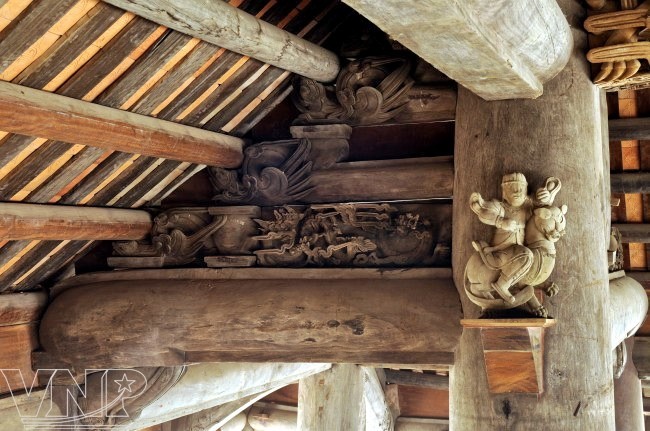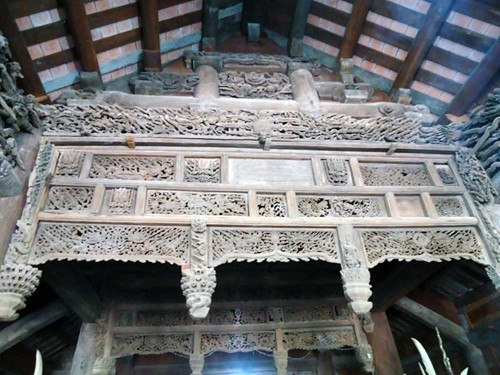(VOVworld)- The sculpture art on Vietnamese communal houses flourished in the late 17th century. The most beautiful communal houses were located in the Red River Delta. For example, Chu Quyen communal house in Ba Vi, Hanoi, Kien Bai communal house in Hai Phong, and Diem communal house in Bac Ninh province.

A corner of Chu Quyen communal house Chu Quyen in Ba Vi. Photo: Tran Huan (baotang.kientrucvietnam.org.vn) |
In Vietnam, the communal house is a place to worship the village’s genie - a national hero or river or mountain genie that blesses local people with peace in their lives. The communal house serves as a residence and a worshiping and meeting place of local people. Each communal house reflects the artistic and historical values of the historical context in which the communal house was built. Painter Phan Cam Thuong who researches ancient Vietnamese art, says:“Sculpture on communal houses is considered a type of folk sculpture because basically it isn’t associated with religion and doesn’t reflect feudal policies but originates from village life. Sculptural decorations on communal houses reflect people’s lives between the 16th and 18th centuries. There are two types of sculptural decorations: patterns of flowers, dragons and clouds and reliefs depicting human activities like hunting, ploughing, kicking a shuttle cock, meetings between boys and girls, etc. Sculpture on communal houses is a description of people’s lives at that time”.

Photo: Tran Huan (baotang.kientrucvietnam.org.vn)
|
In particular, sculpture on communal houses accurately reflects Vietnamese rural life between the 16th and 18th centuries. Many researchers say the most beautiful communal house reliefs are those made in the 17th century. These reliefs reflect the artisans’ romantic views on a reviving world: exciting village festivals, happy family reunions, meetings between lovers and parties. Hunting, arguments between husband and wife, kicking a shuttle cock, shield fighting and cheo singing are also depicted on engraved panels of Vietnamese communal houses in the 17th century. Through each relief, the artisan tells a story about the life in his village. Painter Phan Cam Thuong said:“In Buddhist sculpture, there are certain sculptural conventions for Buddha and Bodhisattva. But on communal houses, there are no rules and sculpture artists can freely carve their products”.
A communal house often consists of three compartments or five compartments, depending on the size and wealth of the village. The roof of the communal house is tiled and a little bit sloping and its four corners are curved like wings in flight. The top edge of the roof is decorated with a band of engraved flowers and a pair of engraved dragons looking to the moon or the sun occupies the middle of the band. Professor Tran Lam Bien studies Vietnamese folk arts: “On the roof, dragons symbolize clouds and the curving corners of the roof symbolize thunders and lighting. On the roof, there are decorations depicting the sun, the moon and unicorns which represent the strength of the upper class, the wisdom and the strength of genies and purity. They are there to control and monitor the souls of pilgrims. Generally, they are all symbols of god and the universe. The tiles and decorative patterns on the tiles symbolize stars”.

Kien Bai Communal House in Haiphong. Photo: doanhnhansaigon.vn |
In general, sculptural decorations on communal house roof reflect people’s lives, aspirations and dreams. Sculptors were free to create their works in the liveliest way. They didn’t have any moulds or have any certain style. They were free to integrate their impressions of life into their work. Unlike religious art, sculptural art on communal houses depicts daily life.